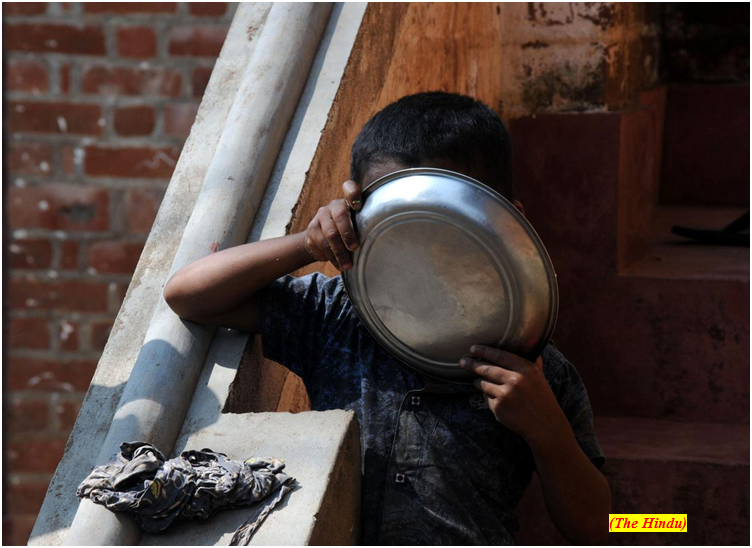Fixing Indias malnutrition problem (GS Paper 2, Issues related to Poverty and Hunger)

Context:
- The Global Hunger Index (GHI) 2022 ranked India 107 out of 121 countries.
- The Government of India attempted to discredit the index immediately in its attempt to deny the findings of the report, even going so far as to term it a conspiracy against India.
Global Hunger Index (GHI) 2022:
- The GHI is an important indicator of nutrition, particularly among children, as it looks at stunting, wasting and mortality among children, and at calorific deficiency across the population.
- India’s National Family Health Survey (NFHS-5) from 2019-21 reported that in children below the age of five years, 35.5% were stunted, 19.3% showed wasting, and 32.1% were underweight.
Gaps in Government schemes:
- Experts have suggested several approaches to address the problem of chronic malnutrition, many of which feature in the centrally-sponsored schemes that already exist. However, gaps remain in how they are funded and implemented, in what one might call the plumbing of these schemes.
- For instance, the Government of India implements the Saksham Anganwadi and Prime Minister’s Overarching Scheme for Holistic Nutrition (POSHAN) 2.0 scheme (which now includes the Integrated Child Development Services (ICDS) scheme), which seeks to work with adolescent girls, pregnant women, nursing mothers and children below three.
- However, the budget for this scheme for FY2022-23 was ₹20,263 crore, which is less than 1% more than the actual spend in FY2020-21, an increase of less than 1% over two years.
- The other flagship scheme of the Government of India is the PM POSHAN, or Pradhan Mantri Poshan Shakti Nirman, known previously as the Mid-Day Meal scheme (National Programme of Mid-Day Meal in Schools).
- The budget for FY2022-23 at ₹10,233.75 crore was 21% lower than the expenditure in FY2020-21.
- Even if accepted that 2020-21 was an exceptional year (due to the COVID-19 pandemic), it is clear that the budgets being allocated are nowhere near the scale of the funds that are required to improve nutrition in the country.
Valid Concerns:
- An Accountability Initiative budget brief reports that per capita costs of the Supplementary Nutrition Programme (one of the largest components of this scheme) has not increased since 2017 and remains grossly underfunded, catering to only 41% of the funds required.
- The budget brief also mentions that over 50% Child Development Project Officer (CDPO) postswere vacant in Jharkhand, Assam, Uttar Pradesh, and Rajasthan, pointing to severe manpower constraints in successfully implementing the scheme of such importance.
- And while PM POSHAN (or MDM) is widely recognised as a revolutionary scheme that improved access to education for children nationwide, it is often embroiled in controversies around what should be included in the mid-day meals that are provided at schools.
- Social audits that are meant to allow for community oversight of the quality of services provided in schools are not carried out routinely.
- There are social factors such as ‘son preference’, which sadly continues to be prevalent in India and can influence household-level decisions when responding to the nutrition needs of sons and daughters. This calls for a comprehensive social education programme, cash alone cannot solve this.
Impact of cash transfer on child nutrition:
- Cash transfers seem to be a favoured solution for several social sector interventions in India today, and this includes the health and nutrition sectors. Much is made of the JAM trinity (Jan Dhan bank accounts, Aadhaar, Mobile).
- Equally appealing is the characteristic of cash transfers as a mechanism that yields rich political dividends. Riding on the digital infrastructure available in India, it is said that targeting the right beneficiaries (i.e., pregnant women and families with children under the age of five) is possible.
- Cash also has the advantage of expanding choice at the household level, as they make decisions on what to put on their plates.
- But evidence of the impact of cash transfer on child nutrition in India is limited so far. Evidence from elsewhere too suggests primarily that while cash transfers improve household food security, they do not necessarily translate into improved child nutrition outcomes.
- Further, a study of the Mamata scheme in Odisha that targeted pregnant and lactating women, showed that there were persistent socio-economic discrepancies in the receipt of cash transfers, especially in comparison to entitlements received through the Public Distribution System (PDS). Thus, cash may be part of the solution, but on its own, it is no panacea.
Recommendations:
- It is clear that malnutrition persists due to depressed economic conditions in large parts of the country, the poor state of agriculture in India, persistent levels of unsafe sanitation practices, etc.
- Cash transfers have a role to play here, especially in regions experiencing acute distress, where household purchasing power is very depressed. Cash transfers can also be used to incentivisebehavioural change in terms of seeking greater institutional support.
- Food rations through PDS and special supplements for the target group of pregnant and lactating mothers, and infants and young children, are essential.
- Persistently under-funded and poorly implemented public programmes (such as the erstwhile ICDS and MDM schemes) must take a large share of the blame for India’s malnutrition problem.
- But getting these schemes right requires greater involvement of local government and local community groups in the design and delivery of tailored nutrition interventions.
- A comprehensive programme targeting adolescent girls is required if the inter-generational nature of malnutrition is to be tackled.
Way Forward:
- The need of the hour is to make addressing child malnutrition the top priority of the government machinery, and all year around.
- A month-long POSHAN Utsav may be good optics, but is no substitute for painstaking everyday work.


